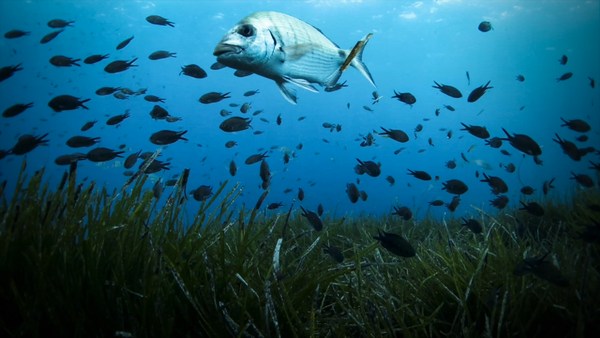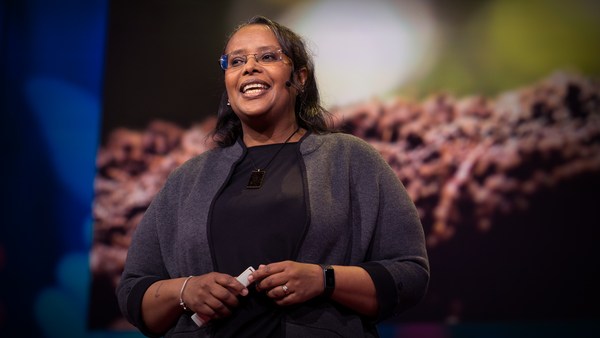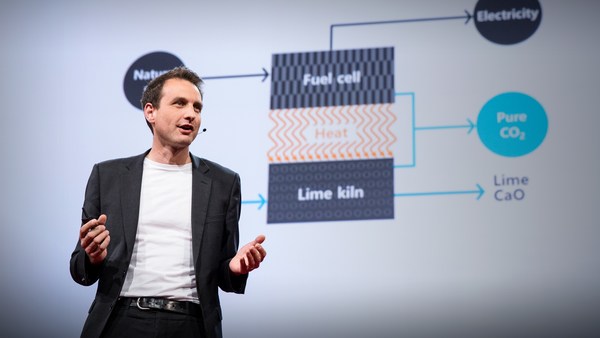So I'm going to talk to you about carbon removals, and I’m going to start with this. This is a woolly pig.
(Laughter)
She's gorgeous, obviously, and she’s also one part in a whole new set of approaches for dealing with climate change. They are all called carbon removals, and they all involve taking CO2 out of the sky and storing it somewhere safe.
I’ll come back to the woolly pig later, but first, why do we need carbon removals? Because I know what you’re thinking: isn’t it easier to stop putting the carbon in the atmosphere in the first place? And the answer is yes, of course it is. We have to do everything we can as fast as we can to stop carbon getting into the sky and stop climate change getting worse. That should not be a controversial point of view at this meeting. But the problem is ... we’ve left it too late. We can't now do it fast enough.
I've been working on climate change for more than 20 years, and I’ve talked about it in boardrooms and classrooms and everywhere in between, and I was shocked when I found this out, but the science is utterly ... utterly clear. If we’re going to have a fighting chance of staying below 1.5 degrees, that “safe limit,” we have to have carbon removals, and it looks like we’re going to need a lot. Scenarios from the Energy Transitions Commission, from the International Energy Agency, from the Intergovernmental Panel on Climate Change, have all shown that we’re going to need billions of tonnes of carbon removals between now and 2050 to give us a chance of staying below 1.5 degrees. We’re going to need both reductions and removals. But there's another more heartening reason why we need carbon removals. They also give us a chance -- our only chance -- not just to stop the problem getting worse, but to make it better. Because even 1.5 degrees isn't actually safe. We’re not there yet, and we’re already experiencing the fires and the floods and the droughts and the storms. With carbon removals, we can take our historical emissions out of the atmosphere. We can clean up the mess we’ve made, and we can give our world a chance to heal.
So what do the removals look like? I’ve been talking to a lot of people about carbon removals, from business executives to climate activists, and they tend to go one of two ways. They either think of trees or they think of big, futuristic machines. Nature versus tech; green versus chrome. But the more I’ve dug into carbon removals, the more I’ve realized this is not the right way to think about them. Because the world is full of ways to store carbon. You can store it in trees, you can store it in soils, you can store it in the ocean, you can store it in buildings, you can store it in rocks, you can store it deep underground. And every one of those approaches requires some combination of natural resources and human ingenuity and technology. We’re going to need both nature and technology. I'll show you what I mean.
So we start on the natural end of the spectrum with trees. Now, I still find it astonishing that every single tree and plant on Earth has made its entire body directly from carbon in the air. They’re incredible carbon capture machines, and we’re going to need a lot more of them. But we also have to do it right, because if you put trees in the wrong place ... they burn. We have to put trees in places where they foster biodiversity, where they don’t compete with food for land and where science and technology tell us they are likely to survive even in the face of climate change.
Now, if you don’t want that CO2 from the burning trees to get into the sky, you can actually burn the wood deliberately in a power station, capture the CO2 and bury it in a process known as BECCS, which also gives you energy as a sideline. But if you want to keep the carbon locked up in the wood, there are technological ways to do that as well, like this one.
Look at this. A whole new movement to use wood as a building material in modern, high-rise buildings. That’s a good idea for at least three reasons. First of all, it keeps the carbon locked up in the wood. Secondly, it displaces high-emitting materials like concrete. And thirdly, the buildings are gorgeous.
Now you can also use technology to help carbon stay locked up in soil. Storing carbon in soil sounds like a good idea, and it is a good idea. The question is how long does the carbon stay there? Because if you change your agricultural practices for one year, two years, that’s fine. But if you ever go back to the old ways, the carbon goes back up into the sky. That’s why this stuff can help. It’s called biochar, and you make it by taking wood and burning it in the absence of oxygen until you get this. It locks the carbon up in the wood, and now it can’t burn away. Now, it turns out that biochar is very good for soils. In fact, Indigenous people in the Amazon have been using it for generations to improve the quality of their soil. We can do that on a much bigger scale, improve the soil and lock up carbon. That’s nature and technology and Indigenous wisdom, all in one sweet package.
Now you can use technology as well ... to speed up natural processes. So this is basalt. It’s a volcanic rock. You can find it more or less everywhere on Earth, and it naturally takes up CO2 in a process called chemical weathering. Unfortunately, it takes thousands of years to do it. But you can speed up the process if you grind up the rock and spread it on fields, and then you can speed it up to just a couple of years. And like biochar, it’s good for the soil. You get minerals in the soil where you need them. And when it washes off into the sea, it can also help with another big bugbear of climate change: ocean acidification. And if we did this on two-thirds of the world’s croplands, we could potentially take up to four billion tonnes of carbon from the atmosphere every year, which is a very big chunk of what we need.
Now, these approaches so far, like planting trees, take a lot of land to be able to get them to scale. But there is one approach where you can actually do it in a very small amount of land, but still get to scale. It’s called direct air capture, and it basically involves massive electric fans blowing a lot of air over a carbon capture device. Now, OK, this does look like a big, futuristic machine. I admit that. But it’s still marrying technology with a natural process -- geology -- because when you’ve captured the CO2, you bury it deep underground.
This is an artist’s impression of a plant that’s being designed by Carbon Engineering in Texas. And its aim is that it will take up one million tonnes of CO2 from the atmosphere every year. And I love this bit -- where does it go? They put it deep underground in the same geological formations that the Texas oil was originally squeezed out of. I love the poetry of this. It’s like reversing the valve and putting the CO2 back where it came from. And recent studies have shown that if you do that, 98 percent of it will still be there in 10,000 years. When you put it down, it stays down. This is still a little bit futuristic. It’s still in the planning and design stages, but this carbon capture plant started operating this year. A smaller scale, but it’s already doing it. This is Climeworks and Carbfix in Iceland. They're using geothermal heat to power it, and they’re putting the CO2 into the Icelandic basaltic rock.
So one issue, though, with direct air capture, is it takes a lot of energy to power those fans. And that energy obviously has to be green. It has to be clean; you can’t use fossil fuels for it. But it also makes it much more expensive than other techniques. And it takes energy to cook wood and to grind rock, and so all of those approaches I’m talking about are currently much more expensive than planting trees. But we can do something about that. We can invest in it now, do the research and development and get them down the cost curve to make them affordable. It worked for solar power; it worked for wind; it can work for carbon removals, too. Remember, we have to get to very big scale: billions of tonnes of carbon removals by 2050. But we can all help by reducing our emissions as much as possible and figuring out how to remove the rest. I’m not talking conventional offsets. You know, I put a tonne of CO2 in the air, and I pay you not to put your tonne in the air, but my tonne’s still there. No, what I mean is I put a tonne of CO2 in the air, I pay someone to take a tonne out of the air, now or in the near future, and we can get to zero and beyond. What goes up must now come down. And if we all do that, if we all make that commitment, then the people trying to make removals happen will have the finance and the courage and the confidence to be able to get to the scale that we need.
I don’t know which of all of these approaches, in the end, are going to be the ones that we’ll have to use to get us to the scale we need. But I do know that we’re going to need a whole spread of them, with nature and technology working hand in hand to take CO2 out of the sky and keep it out. Which brings me neatly back ... to the woolly pigs.
(Laughter)
Now, these woolly pigs live on an estate on the Isle of Mull, which is owned by Jim Mann’s Future Forest Company. And I know they don’t look very dangerous, but they are actually the closest you can get to a native Scottish wild boar without having to have a dangerous animals license. And they do what the Scottish wild boars used to do. They rootle up the undergrowth left over from selective grazing. They let the seed bank come to the surface so that native trees can start to grow and start to take up CO2 from the sky. They're also planting trees in this lovely place. Native broadleaf like oak and this beech tree, and it’s plenty wet enough on the Isle of Mull that they’re not likely to burn. So that’s so far, so natural
But they also have machines. This one is getting ready to cook wood for biochar to go on the soils, and they’ve also got a quarry with basalt. They’re quarrying basalt rock. They’ve got machines to grind up the rock, and they’ve got machines to spread it on the fields. That's three carbon removals approaches in one beautiful place.
Now, it’s just one estate, but all of these approaches and more are hugely scalable. The world is full of places where you can plant trees and put carbon in soil and grind up rock and spread it and capture CO2 from the air and find places to store it underground. All of those things. And there’s hundreds -- thousands of people working right now to get those carbon removals approaches out of the textbook and into practice, and to help us -- God help us -- reverse the damage we have done and start the process of climate healing.
And when I sat on that hillside, and I saw the pigs rootling and the trees growing and the machines getting ready to cook and grind, I loved it ... because I experienced an emotion that those of us who work on climate change very rarely experience. I felt hope.
Thank you.
(Applause and cheers)





